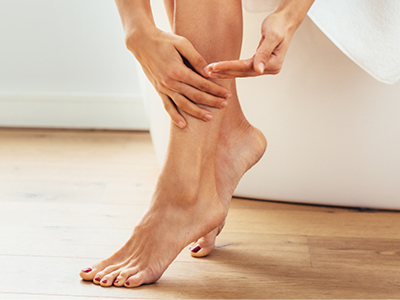03 May How Your Clothes Can Affect Your Skin
 Struggling with a dry skin condition? Read on to find out how the fabrics you wear can be affecting it…
Struggling with a dry skin condition? Read on to find out how the fabrics you wear can be affecting it…
Has anyone ever mentioned to you the importance of the fabrics you choose to wear on your skin? Usually your focus is on feeling comfortable and so you generally turn to loose clothing as they allow your skin to breathe as opposed to tight clothes, which can cause sweating and irritate the skin. Along with how fitted your clothes are, the type of material that is worn is important to consider too as certain fabrics can be irritating and make your skin feel itchier.
Contact dermatitis is a condition where the skin becomes inflamed in response to a material or substance – such as an irritant or allergen – that has come into direct contact with it. Clothing dermatitis (or textile contact dermatitis) is a form of contact dermatitis where irritation is caused by a material or fabric. This can be seasonal due to the fact that certain fabrics are worn at particular times of the year – e.g. wool in winter – or can be as a result of an allergy due to the chemicals that are used during the processing of the fabric e.g. dyes. The condition is more common in women than men, as well as those who are obese or those who work in places where it can get very hot, like bakeries or kitchens and those with atopic dermatitis.
So which fabrics should you avoid?
- Polyester & synthetic/man-made fibres
- Wool
- Rough linen
- Leather
These fabrics can all irritate eczematous skin, causing itching, which leads to scratching and further itching and sets off the itch-scratch cycle.
Synthetic or woollen fabrics don’t allow the skin to breathe so it feels hot and irritated, again causing you to feel the need to scratch your skin, resulting in exacerbated lesions.
If you suffer with psoriasis and find yourself feeling self-conscious about the flaky skin, then try to avoid dark coloured garments and instead go for light or patterned materials as flaky skin is less visible on these fabrics. Also, light coloured clothing tends to have fewer dyes in it so is less likely to irritate your skin.
Try to avoid non-iron clothing as it tends to have been treated with chemicals.

Fabrics you should choose to wear.
Natural, plant-based fibres such as cotton and fine, soft linen are the best. Rough linen is quite a stiff fabric so be aware that it can perhaps annoy rashes on your body, but only because it is not a soft fabric.
You could try wearing organic cotton clothing, however once you wash these with standard washing detergent, then the fact that they are organic becomes irrelevant. Wash your clothes in natural cleaning detergents that are fragrance free, hypoallergenic, free of dyes and made for sensitive skin however bear in mind just because they are natural, doesn’t mean that they will always suit your skin. It’s trial and error with washing powders, but once you find one that suits you, stick with it.
Before buying always check out washing detergent labels but be mindful that not all the ingredients may be listed. Liquids tend to leave fewer residues than powders so these may be a better option and you can also try rinsing your clothes twice.
What do you do if you need to wear a uniform for work or school that’s made of synthetic materials?
Try layering with a thin cotton top under your uniform if the weather allows, thus preventing the synthetic materials from being in direct contact with your skin. Once you get home change out of the clothes as soon as you can, (slipping into your cotton PJ’s is always comforting!) but if you are suffering particularly badly then run yourself a warm bath (for no longer than 15 minutes) and wash yourself with AproDerm® Colloidal Oat Cream or AproDerm® Emollient Cream. Once out of the bath apply it again to skin that is almost dry to trap in moisture.
 The good news is that you don’t need to throw out all of your clothes. Instead, it may be time to start paying more attention to your skin, identifying its needs, and addressing those needs head on. It’s a good idea to moisturise your skin before getting dressed with a product that leaves a protective layer on its surface, thus creating a buffer between the skin and the material. Moisturisers that are also colour free, fragrance free and SLS free – like those in the AproDerm® emollient range – are an ideal choice, because they are specially designed to be gentle on sensitive skin and reduce the risk of irritation.
The good news is that you don’t need to throw out all of your clothes. Instead, it may be time to start paying more attention to your skin, identifying its needs, and addressing those needs head on. It’s a good idea to moisturise your skin before getting dressed with a product that leaves a protective layer on its surface, thus creating a buffer between the skin and the material. Moisturisers that are also colour free, fragrance free and SLS free – like those in the AproDerm® emollient range – are an ideal choice, because they are specially designed to be gentle on sensitive skin and reduce the risk of irritation.
Try to remember to moisturise after getting undressed, too. Making it part of your routine at this time helps to replace lost moisture, whilst aiding the skin to repair itself following any irritation or reactions that may have occurred during the day.



Sorry, the comment form is closed at this time.